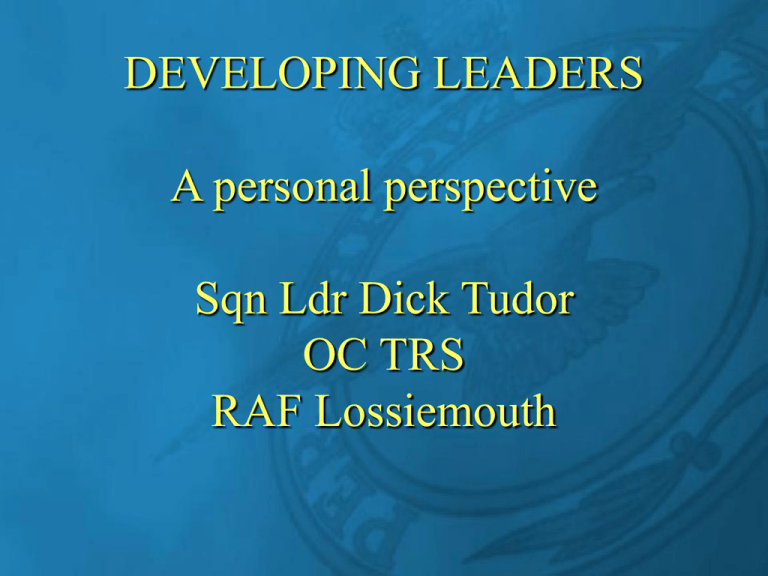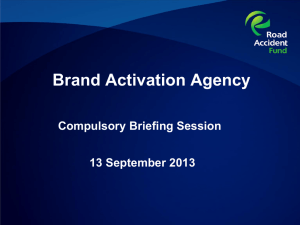Leadership
advertisement

DEVELOPING LEADERS A personal perspective Sqn Ldr Dick Tudor OC TRS RAF Lossiemouth Leadership Development in the RAF “ It is timely to review the RAF’s approach to leadership development to ensure that it is coherent and consistent, thereby assuming excellence across the range of leadership roles.” LEADERSHIP: THE ACADEMIC BACKGROUND The Development of Leadership Theory Period Approach Core Theme Up to late 1940s Trait approach Leadership ability is innate Late 1940s to late 1960s Style approach Leadership effectiveness is to do with how the leader behaves Late 1960s to early 1980s Contingency approach It all depends; effective leadership is affected by the situation Since early 1980s Now Leadership approach Leaders transform the way people feel about themselves The Trait Approach Effective leaders have certain qualities in common Example: intelligence, dependability, sense of responsibility, energy, sociability (e.g. Stogdill – Ohio State Studies) ‘Leaders are born, not made’ Findings not consistent Leadership situation not considered The Style Approach Concern for task – the extent to which the leader emphasises the task objectives Concern for people – the extent to which the leader emphasises the needs, interests etc of the group Directive leadership – the extent to which the leader makes all the decisions regarding group activity Participative leadership – the extent to which the leader shares decision-making concerning group activity (Wright 96) Situational Leadership ‘To be successful in all environments, leaders require a measure of all of the different leadership attributes but their relative importance will be situation and context-dependent.’ Factors Determining Appropriate Leadership Style Maturity of followers or subordinates Existing relationship between them and their leader Clarity and structure of the task or work The position power and personal power of the leader Time available Culture Cross-Cultural Aspects of Leadership ‘Exporting participative leadership from the United States to countries with authoritarian cultures is like preaching Jeffersonian democracy to [those] who believe in the divine right of kings.’ (Haire, Ghiselli and Porter 66) Transformational Leadership Achieving performance beyond normal expectations by changing how people feel about themselves and what is possible and raising their motivation to new highs. Bass and Avolio’s Full-Range Model of Leadership Laissez-faire leadership Transactional leadership – management-byexception and contingent reward Transformational leadership – the four ‘I’s – idealised influence, inspirational motivation, intellectual stimulation, individualised consideration Laissez-faire Leadership Avoiding taking a stand Ignoring problems Not following up Refraining from intervening …leads to conflict and lack of achievement Transactional Leadership Management by exception – passive or active Contingent reward Management by Exception Setting work objective and performance standards Waiting for problems to arise and reacting to them reluctantly, or monitoring for deviations and errors and correcting them Enforcing rules and procedures …leads to continuing status quo, lack of initiative, and avoidance of risk taking by subordinates Contingent Reward Setting work objectives and performance standards Providing feedback Exchanging reward and recognition – e.g. money or praise – for achievement …can lead to expected performance Problems with Transactional Leadership Motivating and rewarding people with ‘carrots’ and punishing them with ‘sticks’ makes them feel like donkeys Lack of consideration for people’s ideas, needs and feelings Focuses only on planning, organizing, directing and controlling – and manipulation by reward Does not develop people to their fullest potential and contribution Transformational Leadership: The Four ‘I’s Individualized consideration Intellectual stimulation Inspirational motivation Idealized influence (Bass 90) LEADERSHIP: LEVELS OF DEVELOPMENT COVEY ON MANAGEMENT Three Levels of Development Organisational development (OD) Team Development Individual or self-development Organisational Development … the applied behavioural science discipline that seeks to improve organisations through planned, systematic, long-range efforts focused on the organisation’s culture and its human and social processes Leadership Development in the RAF “The ability to lead is required at all rank levels of the RAF although the range of leadership attributes required will vary with the level at which the leader is operating.” Creating an Atmosphere for Organisational Development “Central to any organisation improvement program is the creation of a situation in which learning and change can take place by individuals and/or groups” (Schein 99) Leadership Self-Development: The Starting Point Learning to know and control oneself Overcoming emotional barriers Building self-confidence and emotional intelligence Emotional Intelligence “ …refers to the capacity for recognising our own feelings and those of others, for motivating ourselves, and for managing emotions well in ourselves and in our relationships.” (Goleman 98) Three Factors of Leadership Development A person must be motivated to be a leader and to develop the necessary skills The development process should be focused on specific leadership behaviour Provision for practising leadership skills and obtaining feedback (Randell 98) Barriers to Leadership and Leadership Development Low self-esteem – leads to a lack of motivation Lack of self-confidence – as a result of not coming to terms with oneself, can lead to a lack of confidence in others Fear of failure, shame or social disapproval Cognitive constriction – thinking ‘inside the box’ Adverse consequences of stress – cognitive, managerial and physical HOOPER & POTTER ON LEADERS x x OR x TO x x Overcoming the Barriers Desensitisation – gradual increases in difficulty of task – lead to gradual reduction of fear and anxiety Reinforcement theory – reward and recognition for effort and progress Psycho-analytical re-enactment – what was done and what, if anything went wrong, creates a process selfdiscovery Social skill development – based on honesty and trust Group dynamics theory – teams develop cohesiveness through mutual help and support Support for Leadership Development “Individuals are responsible for their own development. Organisations are responsible for providing the enabling resources and ensuring that sufficient leaders are taking advantage of development opportunities.” (London 02) Can You ‘Teach’ Leadership? Yes, but only at the cognitive level Knowing what to do and how to do it is necessary but not sufficient Wanting to do it depends on emotional factors Doing it can only be learned by actually doing it, feedback, application and practice A Definition of Leadership ‘Leadership is the process of influencing the behaviour, beliefs and feelings of other group members in an intended direction.’ (Wright and Taylor 84) The Leadership Trust’s Definition ‘Leadership is using our personal power to win the hearts and minds of people to achieve a common purpose.’ Leadership in the RAF ‘… the RAF requires personnel with strong leadership attributes, excellent managerial skills and the confidence to exercise command.’ Leadership in the RAF And… ‘The successful exercise of command is dependent upon an individual’s professional expertise, management skills and leadership ability.’ Command, Management and Leadership in the RAF ‘Command’ – is a position of authority and responsibility to which individuals are legally appointed ‘Management’ – is concerned with making the best use of resources ‘Leadership’ – is the projection of personality and character to achieve the desired outcome DEALING WITH CHANGE The Leadership Challenges Ahead New technology Deregulation and privatisation Intense competition Increasing inter-dependence Higher-quality products, services and customer care People’s increasing expectations Successful Change Ensures Survival ‘It is not the strongest species that survive, nor the most intelligent, but the ones most responsive to change.’ (Darwin) Change is Difficult ‘There is nothing more difficult to plan, more doubtful of success, nor more dangerous to manage, than the creation of a new system. For the initiator has the enmity of all who would profit by the preservation of the old institutions and merely lukewarm defenders in those who should gain by the new ones.’ (Machiavelli 1510) TRANSFORMATIONAL v TRANSACTIONAL LEADERSHIP Transformational Leadership: The Four ‘I’s Individualized consideration Intellectual stimulation Inspirational motivation Idealized influence (Bass 90) Individualized Consideration Showing concern for the individual Identifying individuals’ abilities and needs Providing matching challenges Providing opportunities to learn Delegating, coaching and giving developmental feedback …leads to a desire to improve and learn Intellectual Stimulation Stimulating people’s intellect and imagination Questioning the status quo Encouraging imagination and creativity Using and encouraging intuition as well as logic …leads to a willingness to think Inspirational Motivation Inspiring people by articulating exciting possibilities Communicating a clear vision Aligning organizational goals with individual goals Treating threats, problems and mistakes as opportunities Using appealing words and symbols Idealized Influence Displaying charisma Expressing confidence in the vision Personally taking full responsibility Displaying a sense of purpose, persistence and trust Emphasizing accomplishments Gaining respect, trust and confidence by personally demonstrating out-of-the-ordinary ability …leads to trust, identification with the leader, and a desire to achieve to show support Charismatic Leaders Show complete self-confidence Show strong determination Are forthright about what is right and wrong, good and bad Are eloquent speakers Are active and energetic Leadership and Idealized Influence ‘No man is a leader until his appointment is ratified in the minds and hearts of his men.’ (US Infantry Journal 48) Empowerment in the RAF “(The) creation of a culture of empowerment is critical to the successful development of future leaders” Leadership and Empowerment ‘Study after study finds that when workers have more control – when they can help define their own goals and hours and when they participate in decision making – their job satisfaction rises.’ (Myers 93) What is Empowerment? Literally, giving people power, making them able to… In practice, giving people the knowledge, skills, opportunity, freedom and resources to manage themselves and be accountable. Why Empower People? Job satisfaction and morale increase Increased effectiveness/efficiency in some private sector companies – e.g. share value rises Enhances self-esteem – a powerful motivator Unless people are empowered, they will never grow ICEBERG 70% Human Potential How Can We Empower People? Understand and develop each individual’s potential and delegate matching challenges Treat people as unique individuals Provide the opportunity, resources, authority, training and coaching for people to perform Stimulate people’s intellects and emotions The Enemies of Empowerment Lack of trust Fear of the consequences of taking risks Requirements of the Leader for Empowerment Ability and desire to respond positively to people’s needs and interests Time and availability Trust Preparedness to take risks and let go Lack of self-centeredness Emotional intelligence Empowering People Requires Emotional Intelligence Self-awareness as a leader – especially your need for control Self-confidence Recognizing others’ feelings and needs Interpersonal skills Trust HOOPER & POTTER ON TEAM LEADERSHIP EXECS’ LEADERSHIP MODULE: ACADEMIC INTRODUCTION The Issues ‘Leaders are born, not made. Discuss.’ Leadership development programmes are prolific and costly Are they effective? Can leadership be “taught” – or even learned? The Learning Organisation “ … organisations where people continually expand their capacity to create the results they truly desire, where new and expansive patterns of thinking are nurtured, where collective aspiration is set free, and where people are continually learning how to learn together.” (Senge 90) The Importance of The Learning Organisation “The organisations that will truly excel in the future will be the organisations that discover how to tap people’s commitment and capacity to learn at all levels in an organisation.” (Senge 90) Learning Leadership Variety of conventional and unconventional methods Need for learning by doing Feedback (e.g. 3600) and training Leaders as teachers Leadership as Influence “Most definitions of leadership have made the assumption that leadership involves a process of influence by one person over other people.” (Yukl 02) Etymology ‘Management’ comes from the Latin manus (‘a hand’) – to do with handling objects, e.g. machines ‘Leadership’ comes from the AngloSaxon leader (‘road’ or ‘path’) – to do with a sense of direction ‘Managers are people who do things right. Leaders are people who do the rights things.’ (Bennis 84) Leadership and Management are not Mutually Exclusive Not been supported by empirical research People did not sort neatly into the two stereotypes The stereotypes implied managers were always ineffective Insensitive to denigrate ‘managers’ in organisations with a negative stereotype. Leadership v Management Management produces orderly results which keep things working efficiently Leadership creates useful change We need both if organisations and nations are to prosper (Kotter 90)











